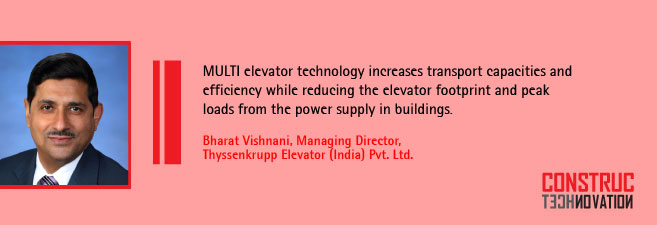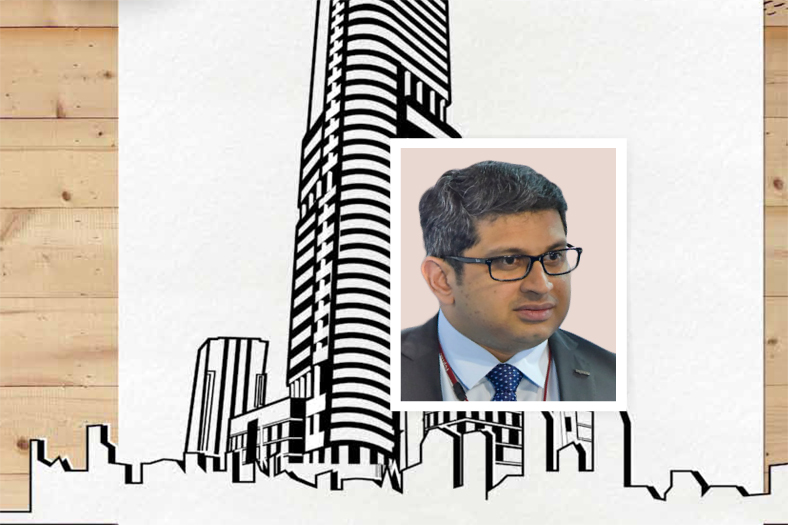Rope-free elevators: A future transport solution

MULTI elevator technology increases transport capacities and efficiency while reducing the elevator footprint and peak loads from the power supply in buildings.
A new era of elevators is set to revolutionise high-rise and mid-rise construction. With the continuing construction boom in India, buildings are getting taller and owners are placing greater demands on their elevators to provide increasing passenger transportation capacity, observes Bharat Vishnani, Managing Director, Thyssenkrupp Elevator (India) Pvt. Ltd. He says, “In this context, Thyssenkrupp’s innovative TWIN elevator system can save time and space. It is the only elevator system on the market that has two cars moving independently in one shaft and addresses a range of issues that owners, operators and occupants of tall buildings face daily. Thyssenkrupp’s intelligent destination-selection control (DSC) system minimises travel time by reducing the number of stops each elevator makes.”
TWIN provides building owners with the choice of better traffic-handling capacity without increasing the footprint of the elevator core, or the same handling capacity as a conventional elevator system but with a smaller core. Furthermore, an unexpected design benefit of TWIN is the visual impact its panoramic car option can bring to a building exterior or atrium. In addition to maximising passenger-handling capacity for new buildings, TWIN can be retrofitted as a modernisation option to increase the traffic-handling capacity of existing elevator shafts by boosting the system’s capacity.
Rope-free elevator systems
After 160 years, the era of rope-dependent elevators may finally be over as Thyssenkrupp develops the world’s first rope-free elevator system MULTI to enable the building industry to face the challenges of global urbanisation. MULTI is Thyssenkrupp’s latest offering representing a landmark revolution in the elevator industry and a new and efficient transport solution for mid- and high-rise buildings.
MULTI design can incorporate various self-propelled elevator cabins per shaft running in a loop, thereby increasing the shaft transport capacity by up to 50 per cent and making it possible to reduce the elevator footprint in buildings by as much as 50 per cent. “MULTI elevator technology increases transport capacities and efficiency while reducing the elevator footprint and peak loads from the power supply in buildings. The first MULTI unit will soon be tested in the test tower in Rottweil, Germany, with three of the twelve shafts in the test tower exclusively for this new elevator system,” says Vishnani.

MULTI requires no cables, and uses a multi-level brake system and inductive power transfers between shafts and cabins. This allows the elevator to occupy smaller shafts than conventional elevators, which can increase a building’s usable area by up to 25 per cent. The overall increase in efficiency also translates into a lower requirement for escalators and additional elevator shafts, resulting in significant construction cost savings as well as a multiplication of rent revenues from increased usable space.
Discuss about how MULTI is going to change the construction landscape Vishnani said, “As the nature of building constructions evolves, it is also necessary to adapt elevator systems to better suit the requirements of buildings and high volumes of passengers. From the one dimensional vertical arrangement to a two dimensional horizontal/vertical arrangement with more than one or two cabins operating in each shaft, MULTI represents a proud moment in Thyssenkrupp’s history of presenting cutting-edge transport technologies that best serve current as well as future mobility needs.”
MAX: Most advanced technology introduced in past one year
Aiming to ease stress in the lives of over one billion people who use elevators each day-a number expected to rise as urban population increase by 3 billion in the next three decades, Thyssenkrupp has launched its Internet of Things (IoT)-based predictive service solution MAX to significantly increase elevator availability by reducing out-of-service situations through real-time diagnostics.
Powered by the Microsoft Azure IoT technology, MAX extends remote monitoring capabilities to dramatically increase current availability levels of existing and new elevators. MAX makes it possible for an elevator to ‘tell’ service technicians its real needs, including real-time identification of repairs, component replacements, and proactive system maintenance. Thyssenkrupp expects to connect MAX in over 15,000 elevators by the end of 2017, as part of its larger plan to connect 180,000 elevators worldwide during the same period.
Cookie Consent
We use cookies to personalize your experience. By continuing to visit this website you agree to our Terms & Conditions, Privacy Policy and Cookie Policy.









